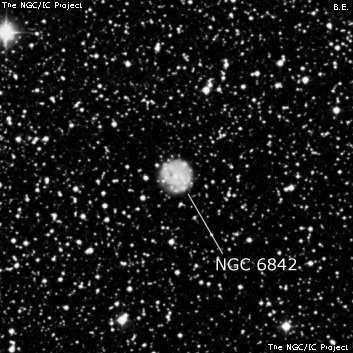NGC/IC Project Restoration Effort
(This is a very very beta version)
NGC6842


Basic Information
Location and Magnitude
Right Ascension: 19:55:2.3
Declination: +29:17:23
Constellation: VUL
Visual Magnitude: 13.1
Historic Information
Discoverer: Marth
Year of discovery: 1863
Discovery aperture: 48.0
Observational
Summary description: F, pL, vlE
Sub-type: PN
Corwin's Notes
=====
NGC 6842. Is this also NGC 6847 (which see)? Probably not, but it is a
possibility.
Steve's Notes
=====
NGC 6842
24" (9/1/16): at 375x and 500x (unfiltered); moderately bright and large, round, ~50" diameter, crisp edge to the rim, fairly evenly illuminated. The mag 15.5-16 central star was visible, along with several nearby stars; a mag 15.5 star is just off the NE edge [38" from center], a mag 15 star is off the south edge [47"] and a mag 14 star is off the east edge [50"]. Using 220x with a UHC filter, the planetary is fairly bright and the rim appears slightly brighter in sections.
18" (8/26/06): a sketch was made at 435x showing the numerous faint stars that huddle nearby this planetary. A mag 14 star is off the east edge [50" from center] and a mag 14.5 star is just off the south end [47" from center]. A mag 15-15.5 star is barely off the NE edge [38" from center] and an extremely faint mag 16 star is at the NNW edge. A mag 13.5 star is 1.1' SE. Finally a very faint central star is often visible.
17.5" (8/7/91): fairly bright, moderately large, irregularly round, soft edges. A very faint mag 15.5 central star is visible and a second extremely faint mag 16.0 star is near the east edge star. Several stars are at the edges including a mag 15-15.5 star at the NE edge and two mag 13-14 stars off the east side. Appears brighter around the central star.
13.1" (7/12/86): at 62x and OIII filter appears moderately bright, moderately large, estimate V = 13.0. A mag 14.5 star is off the east edge. NGC 6834 lies 38' WNW.
8" (9/81): I was surprised to glimpse NGC 6842 from home in El Cerrito (limiting mag of 4.5) using a Daystar 300 filter at 125x, even with black hood, averted vision and concentration. Walter Scott Houston wrote about this observation in detail in his Deep Sky Wonder's column of November 1982.
8" (7/31/81): extremely faint, fairly small, diffuse. Located in a rich star field.



